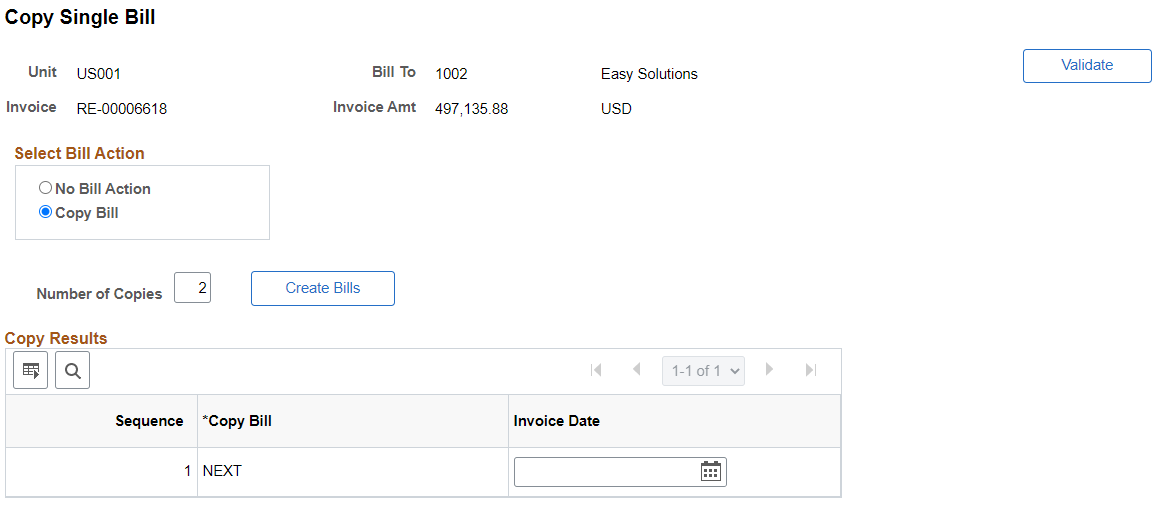Copying Bill Information
This topic provides an overview of copying bill information and discusses how to copy bills.
|
Page Name |
Definition Name |
Usage |
|---|---|---|
|
BI_BILL_CPY |
Copy a bill. This utility is helpful if you must send out new bills with all or most of the same information on it as another bill. |
You can copy a single bill when you must send out a new bill with all or most of the same information on it as another bill. Bills that cannot be copied are:
Temporary bills, which have a status of TMR and TMP.
Bills that are not confirmed for Financial Sanctions Screening (FSS).
If your system is activated to perform FSS, your newly copied invoice will go through FSS again. For example, if you have loaded an updated financial sanctions list since the original invoice was validated, you should perform another validation on the new bills. Use the Screen for Denied Parties process or the Finalization process to perform the FSS on the new bill.
Use the Copy Single Bill page (BI_BILL_CPY) to copy a bill. This page allows you to create new bills with all or most of the same information on it as another bill.
Navigation:
This example illustrates the fields and controls on the Copy Single Bill.

Field or Control |
Description |
|---|---|
|
Validate |
Select to validate the selected bill for errors before doing a copy. Validation errors are displayed on the Validate Errors Page (Adjust Entire, Adjust Selected, Copy Single). |
Select Bill Action |
To run the copy bill function, select Copy Bill. This group box appears as No Bill Action by default when the page initially appears to prevent you from copying a bill prematurely. |
Number of Copies |
Select the number of copies to be created. Number of Copies option is available only when the Select Bill Action option is Copy Bill. The default value is 1. |
Create Bills |
Click the Create Bills button to add the number of rows specified in the Number of Copies option to the Copy Results grid. |
Copy Bill |
Displays a default value of NEXT, indicating that the system assigns the next invoice number that is available to the new bill when you select Copy Bill in the Select Bill Action group box. You can enter an invoice ID here if you are authorized to assign invoice numbers. Define valid invoice IDs on the Invoice Number page. See Assigning Invoice Number IDs. |
Invoice Date |
Enter an invoice date for the bill copy. If no invoice date is provided, then current date will be populated as the invoice date for the newly created bill. |
Save |
Click to run the copy function. After you run the copy bill function, the Copy Bill field in the Copy Results group box displays the invoice number that is assigned to the new bill. Also, Select Bill Action is reset to No Bill Action. The system copies all bill information—including any discounts, surcharges, notes, and accounting distributions, but excluding bill status to the new bill. The system creates the new bill with a status of NEW, and with a current date bill added. To run the copy bill function again on the same bill, select Copy Bill in the Select Bill Action group box, provide the number of copies, click Create Bills and click Save. To run the copy function on another bill, select that bill from the search results list, or exit this page and specify another bill to copy. |
When you run the copy bill or copy bill group functions, the system does not copy every field; it resets some fields to default values.
See Resetting Field Values When Copying Invoices.
Note: When you copy a bill that originated in PeopleSoft Order Management, a bill with a system source of OBI, the system clears the system source in the new bill to enable you to change the customer ID and send the new bill to another customer. For example, if you bill the wrong customer and want to credit the original customer, create a copy of the bill and change the customer ID. Adhere to any warning messages that appear when you save the change in the customer ID on the new bill.